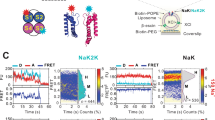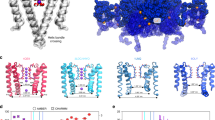Abstract
Potassium channels selectively conduct K+ ions across cell membranes, and use diverse mechanisms to control their gating. We studied ion permeation and gating of an inwardly rectifying K+ channel by individually changing the amide carbonyls of two conserved glycines lining the selectivity filter to ester carbonyls using nonsense suppression. Surprisingly, these backbone mutations do not significantly alter ion selectivity. However, they dramatically change the kinetics of single-channel gating and produce distinct subconductance levels. The mutation at the glycine closer to the inner mouth of the pore also abolishes high-affinity binding of Ba2+ to the channel, indicating the importance of this position in ion stabilization in the selectivity filter. Our results demonstrate that K+ ion selectivity can be retained even with significant reduction of electronegativity in the selectivity filter, and that conformational changes of the filter arising from interactions between permeant ions and the backbone carbonyls contribute directly to channel gating.
This is a preview of subscription content, access via your institution
Access options
Subscribe to this journal
Receive 12 print issues and online access
$209.00 per year
only $17.42 per issue
Buy this article
- Purchase on Springer Link
- Instant access to full article PDF
Prices may be subject to local taxes which are calculated during checkout






Similar content being viewed by others
References
Hille, B. Ionic Channels of Excitable Membranes 2nd edn. (Sinauer, Sutherland, Massachusetts, 1992).
Doyle, D. A. et al. The structure of the potassium channel: molecular basis of K+ conduction and selectivity. Science 280, 69–77 (1998).
Yellen, G. The moving parts of voltage-gated ion channels. Q. Rev. Biophys. 31, 239–295 (1998).
Holmgren, M., Smith, P. L. & Yellen, G. Trapping of organic blockers by closing of voltage-dependent K+ channels: evidence for a trap door mechanism of activation gating. J. Gen. Physiol. 109, 527–535 (1997).
Liu, Y., Jurman, M. E. & Yellen, G. Gated access to the pore of a voltage-dependent K+ channel. Neuron 19, 175–184 (1997).
del Camino, D., Holmgren, M., Liu, Y. & Yellen, G. Blocker protection in the pore of a voltage-gated K+ channel and its structural implications. Nature 403, 321–325 (2000).
Perozo, E., Cortes, D. M. & Cuello, L. G. Structural rearrangements underlying K+-channel activation gating. Science 285, 73–78 (1999).
Hoshi, T., Zagotta, W. N. & Aldrich, R. W. Biophysical and molecular mechanisms of Shaker potassium channel inactivation. Science 250, 533–538 (1990).
Isacoff, E. Y., Jan, Y. N. & Jan, L. Y. Putative receptor for the cytoplasmic inactivation gate in the Shaker K+ channel. Nature 353, 86–90 (1991).
Holmgren, M., Jurman, M. E. & Yellen, G. N-type inactivation and the S4-S5 region of the shaker K+ channel. J. Gen. Physiol. 108, 195–206 (1996).
Lopez-Barneo, J., Hoshi, T., Heinemann, S. H. & Aldrich, R. W. Effects of external cations and mutations in the pore region on C-type inactivation of Shaker potassium channels. Receptors Channels 1, 61–71 (1993).
Liu, Y., Jurman, M. E. & Yellen, G. Dynamic rearrangement of the outer mouth of a K+ channel during gating. Neuron 16, 859–867 (1996).
Kiss, L., LoTurco, J. & Korn, S. J. Contribution of the selectivity filter to inactivation in potassium channels. Biophys. J. 76, 253–263 (1999).
Amstrong, C. M. Interaction of tetraethylammonium ion derivatives with the potassium channels of giant axon. J. Gen. Physiol. 58, 413–437 (1971).
Swenson, R. P. & Armstrong, C. M. K+ channels close more slowly in the presence of external K+ and Rb+. Nature 291, 427–429 (1981).
Neyton, J. & Pelleschi, M. Multi-ion occupancy alters gating in high-conductance, Ca2+-activated K+ channels. J. Gen. Physiol. 97, 641–665 (1991).
Demo, S. D. & Yellen, G. Ion effects on gating of the Ca2+-activated K+ channels correlate with occupancy of the pore. Biophys. J. 61, 639–648 (1992).
Heginbotham, L., Lu, Z., Abramson, T. & MacKinnon, R. Mutations in the K+ channel signature sequence. Biophys. J. 66, 1061–1067 (1994).
Chapman, M. L., VanDongen, H. M. A. & VanDongen, A. M. J. Activation-dependent subconductance levels in the drk1 K+ channel suggest a subunit basis for ion permeation and gating. Biophys. J. 72, 708–719 (1997).
Zheng, J. & Sigworth, F. J. Selectivity changes during activation of mutant shaker potassium channels. J. Gen. Physiol. 110, 101–117 (1997).
Zheng, J. & Sigworth, F. J. Intermediate conductances during deactivation of heteromultimeric shaker potassium channels. J. Gen. Physiol. 112, 457–474 (1998).
Nichols, C. G. & Lopatin, A. N. Inward rectifier potassium channels. Annu. Rev. Physiol. 59, 171–191 (1997).
Sakmann, B. & Trube, G. Conductance properties of single inwardly rectifying potassium channels in ventricular cells from guinea-pig heart. J. Physiol. (Lond.) 347, 641–657 (1984).
Sakmann, B. & Trube, G. Voltage-dependent inactivation of inwardly-rectifying single-channel currents in the guinea-pig heart cell membrane. J. Physiol. (Lond.) 347, 659–683 (1984).
Choe, H., Sackin, H. & Palmer, L. G. Permeation and gating of an inwardly rectifying potassium channel: evidence for a variable energy well. J. Gen. Physiol. 112, 433–446 (1998).
Choe, H., Palmer, L. G. & Sackin, H. Structural determinants of gating in inward-rectifier K+ channels. Biophys. J. 76, 1988–2003 (1999).
Noren, C. J., Anthony-Cahill, S. J., Griffith, M. C. & Schultz, P. G. A general method for site-specific incorporation of unnatural amino acids into proteins. Science 244, 182–188 (1989).
Elllman, J. A., Mendel, D. & Schultz, P. G. Site-specific incorporation of novel backbone structures into proteins. Science 255, 197–200 (1992).
Mendel, D., Cornish, V. W. & Schultz, P. G. Site-directed mutagenesis with an expanded genetic code. Annu. Rev. Biophys. Biomol. Struct. 24, 435–462 (1995).
Nowak, M. W. et al. Nicotinic receptor binding site probed with unnatural amino acid incorporation in intact cells. Science 268, 439–442 (1995).
England, P. M., Zhang, Y., Dougherty, D. A. & Lester, H. A. Backbone mutations in transmembrane domains of a ligand-gated ion channels: Implications for the mechanism of gating. Cell 96, 89–98 (1999).
Wiberg, K. B. & Laidig, K. E. Barriers to rotation adjacent to double bonds. 3. The C–O barrier in formic acid, methyl formate, acetic acid, and methyl acetate. The origin of ester and amide “resonance”. J. Am. Chem. Soc. 109, 5935–5943 (1987).
Lu, T., Nguyen, B., Zhang, X.-M. & Yang, J. Architecture of a K+ channel inner pore revealed by stoichiometric covalent modification. Neuron 22, 571–580 (1999).
Creighton, T. E. H. Proteins: Structures and Molecular Properties 2nd edn. (W. H. Freeman and Company, New York, 1993).
Stanfield, P. R. et al. A single aspartate residue is involved in both intrinsic gating and blockage by Mg2+ of the inward rectifier, IRK1. J. Physiol. (Lond.) 478, 1–6 (1994).
Lopatin, A. N., Makhina, E. N. & Nichols, C. G. Potassium channel block by cytoplasmic polyamines as the mechanism of intrinsic rectification. Nature 372, 366–369 (1994).
Ficker, E., Taglialatela, M., Wible, B. A., Henley, C. M. & Brown, A. M. Spermine and spermidine as gating molecules for inward rectifier K+ channels. Science 266, 1068–1072 (1994).
Yang, J., Jan, Y. N. & Jan, L. Y. Control of rectification and permeation by residues in two distinct domains in an inward rectifier K+ channel. Neuron 14, 1047–1054 (1995).
Jin, W.-L. & Lu, Z. A novel high-affinity inhibitor for inward-rectifier K+ channels. Biochemistry 37, 13291–13299 (1998).
Slesinger, P. A. et al. Functional effects of the mouse weaver mutation on G protein-gated inwardly rectifying K+ channels. Neuron 16, 321–331 (1996).
Kofuji, P. et al. Functional analysis of the weaver mutant GIRK2 K+ channel and rescue of weaver granule cells. Neuron 16, 941–952 (1996).
Silverman, S. K., Kofuji. P., Dougherty, D. A., Davidson, N. & Lester., H. A. A regenerative link in the ionic fluxes through the weaver potassium channel underlies the pathophysiology of the mutation. Proc. Natl. Acad. Sci. USA 93, 15429–15434 (1996).
Jiang, Y. & MacKinnon, R. The barium site in a potassium channel by X-ray crystallography. J. Gen. Physiol. 115, 269–272 (2000).
Shieh, R.-C., Chang, J.-C. & Arreola, J. Interaction of Ba2+ with the pores of the cloned inward rectifier K+ channels Kir2.1 expressed in Xenopus oocytes. Biophys. J. 75, 2313–2322 (1998).
Aqvist, J. & Luzhkov, V. Ion permeation mechanism of the potassium channel. Nature 404, 881–884 (2000).
Bernèche, S. & Roux, B. Molecular dynamics of the KcsA K+ channel in a bilayer membrane. Biophys. J. 78, 2900–2917 (2000).
Capener, C. E. et al. Homology modeling and molecular dynamics simulation studies of an inward rectifier potassium channel. Biophys. J. 78, 2929–2942 (2000).
Shrivastava, I. H. & Sansom, M. S. P. Simulations of ion permeation through a potassium channel: molecular dynamics of KcsA in a phospholipid bilayer. Biophys. J. 78, 557–570 (2000).
Khakh, B. S. & Lester, H. A. Dynamic selectivity filters in ion channels. Neuron 23, 653–658 (1999).
Saks, M. E. et al. An engineered Tetrahymena tRNAGln for in vivo incorporation of unnatural amino acids into proteins by nonsense suppression. J. Biol. Chem. 271, 23169–23175 (1996).
Acknowledgements
We thank V.W. Cornish for her participation in the early stage of this work, S. Siegelbaum and members of his lab for discussions, and S. Siegelbaum and W. Sather for comments on a previous version of the manuscript. We also thank H. Lester and D. Dougherty for the tRNA gene and Z. Lu for a gift of tertiapin. This work was supported by grants from the NIH (J.Y., L.Y. J. and P.G.S.), the NSF (A.Y.T.), the Alfred Sloan Foundation (J.Y.) and the HHMI (L.Y. J. and P.G.S.).
Author information
Authors and Affiliations
Corresponding author
Rights and permissions
About this article
Cite this article
Lu, T., Ting, A., Mainland, J. et al. Probing ion permeation and gating in a K+ channel with backbone mutations in the selectivity filter. Nat Neurosci 4, 239–246 (2001). https://doi.org/10.1038/85080
Received:
Accepted:
Issue Date:
DOI: https://doi.org/10.1038/85080
This article is cited by
-
Subunit gating resulting from individual protonation events in Kir2 channels
Nature Communications (2023)
-
The permeation of potassium and chloride ions through nanotubes: a molecular simulation study
Monatshefte für Chemie - Chemical Monthly (2014)
-
On the structural basis of modal gating behavior in K+ channels
Nature Structural & Molecular Biology (2011)
-
Structural mechanism of C-type inactivation in K+ channels
Nature (2010)
-
Functional consequences of Kir2.1/Kir2.2 subunit heteromerization
Pflügers Archiv - European Journal of Physiology (2010)



